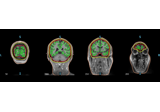mne.bem.make_flash_bem#
- mne.bem.make_flash_bem(subject, overwrite=False, show=True, subjects_dir=None, flash_path=None, copy=True, *, flash5_img=None, register=True, verbose=None)[source]#
Create 3-Layer BEM model from prepared flash MRI images.
- Parameters:
- subject
str Subject name.
- overwritebool
Write over existing .surf files in bem folder.
- showbool
Show surfaces to visually inspect all three BEM surfaces (recommended).
- subjects_dirpath-like |
None The path to the directory containing the FreeSurfer subjects reconstructions. If
None, defaults to theSUBJECTS_DIRenvironment variable.- flash_path
str|None [DEPRECATED] Use the flash5_img parameter instead.
Path to the flash images. If None (default), mri/flash/parameter_maps within the subject reconstruction is used.
New in version 0.13.0.
Changed in version 1.1: Deprecated
- copybool
If True (default), use copies instead of symlinks for surfaces (if they do not already exist).
New in version 0.18.
Changed in version 1.1: Use copies instead of symlinks.
- flash5_img
None| path-like |Nifti1Image The path to the synthesized flash 5 MRI image or the image itself. If None (default), the path defaults to flash5.mgz within the flash_path folder. If not present the image is copied or written to the flash_path folder as flash5.mgz.
New in version 1.1.0.
- registerbool
Register the flash 5 image with T1.mgz file. If False, we assume that the images are already coregistered.
New in version 1.1.0.
- verbosebool |
str|int|None Control verbosity of the logging output. If
None, use the default verbosity level. See the logging documentation andmne.verbose()for details. Should only be passed as a keyword argument.
- subject
See also
Notes
This program assumes that FreeSurfer is installed and sourced properly.
This function extracts the BEM surfaces (outer skull, inner skull, and outer skin) from a FLASH 5 MRI image synthesized from multiecho FLASH images acquired with spin angles of 5 and 30 degrees.
